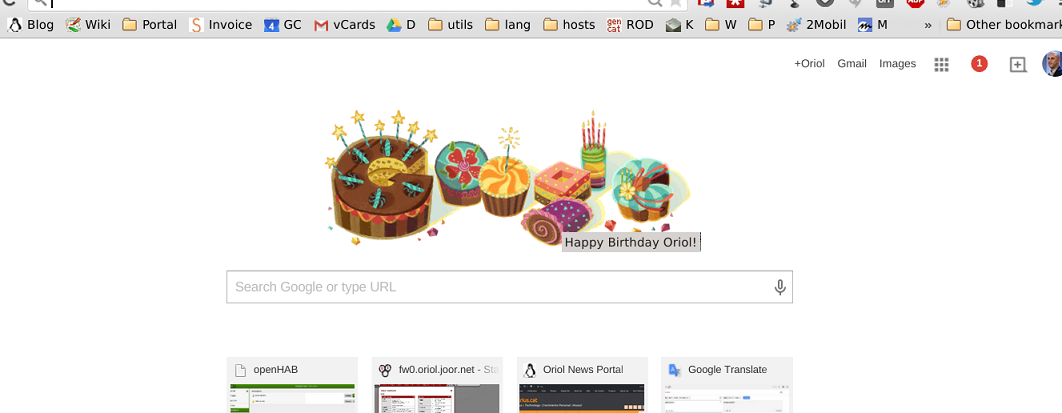15 anys amb el blog online
Avui dia 31 de juliol fa 15 anys que vaig decidir-me a escriure el meu primer article al blog. Com passa el temps! cada cop que penso que el dia que vaig començar no sabia ni el que era un blog i que l’anomenava “digital diary”. Sovint escric tot dient que tinc l’agenda plena i que no sé d’on treure temps per escriure. Doncs bé, després d’un periode molt i molt llarg de temps on el meu vincle en diversos projectes m’impedia dedicar temps al blog puc dir que tot i tenir una llista de desitjos quasi infinita. Ja no tinc obligacions fortes en projectes fora dels horaris convencionals. Així doncs, en pocs mesos disposaré de temps per gestionar en els meus interessos personals cosa que fins ara no tenia.

De moment el meu proposit serà anar publicant alguns dels molts articles que tinc a mig fer i pendents de fer publics. Desitjo que aquest proper any la freqüència de publicacions al blog canviï dràsticament. Creuem els dits perquè pugui mantenir el desig.
Gràcies a tots els fidels seguidors que teniu la paciència d’anar-me seguint.
Conferència Summer Camp Garrotxa 2015: SmartHome usant Arduino, Raspberry PI i més
Aquest cap de setmana vaig tornar a donar la meva conferència sobre “SmartHome” en aquesta ocasió vaig introduïr la novetat del sistema de feedback basat en “Tasker + Auto-notification”, a més de l’execusió de tasques basades en “crontab”. També he inclòs un petit avanç sobre el nou projecte en el que estic treballant per tal d’integrar les dades del descalcificador dins del OpenHAB usant una webcam i OpenCV per processar les imatges optingudes.
Agraïr al Xavi, Gerardo i la Laura per haver-me donat aquesta oportunitat. Tant el SCG15 com el SAX2015 són events molt familiars a més l’entorn és espectacular. Tot un descobriment del que malgrat tenir referències no havia pogut disfrutar en primera persona.
Reflexions d’aniversari: avui 38
En dies com avui sempre aprofito per fer les meves reflexions. Aquests quasi 15 anys que porto escribint el blog alguns cops les he compartit amb vosaltres, doncs avui em ve de gust tornar-ho a fer. Si algo he après després de 38 primaveres és que les coses bones ho són encara més si les pots compartir. A tots ens agrada compartir els moments d’alegria però es fa més difícil obrir-se quan es tracta de mostrar el dolor; malgrat tot en més d’una ocasió he decidit també compartir els moments durs que m’ha tocat viure.
Culturalment els aniversaris sempre se m’han presentat com una alegria, malgrat algunes persones s’esforcen en amagar anys i en entristir-se de l’edat que van acumulant. En general tothom parla de celebracions i actes festius per compartir amb alegria l’efemèride. L’any passat com la majoria sabeu el dia va estar marcat per una sombra molt trista, la història del Pol, i obviament això marca molt. És a dir, que fa pocs dies va fer un any i aquest tipus de coses deixen una petjada molt fonda.
Amb tot plegat el que vull dir és el que recordava fa un parell de dies quan agraïa la nova oportunitat que m’havia donat la vida després de l’accident que vaig patir fa 12 anys (Fa 12 anys que vaig tornar a neixer). La vida és un regal fantàstic plena de lliçons constants, algunes són tan espectaculars que ens fan dividir la vida en un abans i un després dels fets. Estic convensut que cadascú de nosaltres en té unes quantes d’aquestes lliçons. Això ho dic perquè quan miro enrera i hem poso a repassar aquests punts d’inflexió veig que me n’ha tocat viure uns quants i alguns de ben grossos. És a dir, que han marcat canvis molt importants.
Quan jo tenia 9 anys el meu pare ens va deixar en un accident de feina, des d’aquell moment vaig tenir clara una cosa; la definició de “normal” ja no m’aplicava. Al sentir les típiques frases que et deien a l’escola “digueu als pares…” o, “que vinguin a veurem els pares…” cada cop que sentia això jo em sentia molt diferent. Amb la perspectiva que hem dona el temps ara veig que això em va marcar molt el caràcter.
Una de les coses que vaig aprendre és a acceptar el que hem tocava viure i a agafar consciència de quines eren les avantatges i inconvenients que tenia a l’abast en cada moment. Això em va convertir en algú molt perseverant i fins hi tot alguns dieren que un lluitador. Cosa que després d’acabar la carrera em va permetre tenir un perfil professional molt diferencial amb la majoria de persones que tenia al voltant. Tan és així que trets negatius com la sopèrbia i el despotisme s’havia incorporat en la meva forma d’actuar.
Però la vida sempre té una nova lliçó apunt per fer-te tornar a tocar de peus a terra, en aquest cas va ser l’accident de cotxe al que feia referència abans. Obviament un cop tan fort et fa reflexionar i un nou procés de transformació es va iniciar dins meu. Gràcies a persones excepcionals a més de tècniques com la PNL i el coaching vaig iniciar un treball personal d’autoconeixment i de modelat de mi mateix que de ben segur no acabarà fins el dia que m’acomiadi d’aquest món.
Sort que gràcies a les dosis d’humilitat que he anat revent fa molts anys que he agafat consciència de que no sóc ningú i que la meva existència esta condicionada a unes energies tan poderoses que escapen del meu control, sense oblidar que sóc jo com decideixo viure aquests fets. Perquè de nou “La història del Pol” em va arribar en un moment de plenitut després d’haver iniciat un procés fantàstic amb l’Estefania i un projecte professional molt motivador. Així que ara mateix no tinc la perspectiva suficient com per entendre al 100% el missatge que em vol donar la vida amb aquesta lliçó però com repeteixo dia rera dia: gràcies per permetrem seguir endavant i poder compartir el millor de mi mateix.
A tots els que d’una forma o d’una altre heu compartit i/o compartiu el camí de la meva vida, només ús puc donar les gràcies. No oblideu que d’una forma o d’una altre sou mestres que m’heu ajudat a creixer i a evolucionar fins a convertir-me en el que sóc.
“” El que tinc m’ho han donat els meus èxits,
però el que sóc és fruit dels meus errors. “”— Oriol Rius
Free dynamic DNS service
A long time ago there were several free dynamic DNS services but nowadays it’s difficult to find one of them. And when you find the service usually you have some important restrictions like: number of updates per day or only few subdomains per account. But in the end I found a good free service of that, it’s part of the project guifi.net and is called: Qui; you only need a guifi.net account to use the service and it’s really simple and clear. From my part the compatibility with “ddclient” and the “mikrotik” script are really useful and I want tu highlight this functionality.
Fa 12 anys que vaig tornar a neixer
De tant en tant em ve al cap aquella expressió que diu: “Hi ha coses a la vida que la divideixen en dos, es marca un abans i un després de…”. Doncs bé, avui es compleixen 12 anys d’un dels fets que ha dividit la meva vida. Tal dia com avui hem dirigia a una reunió a València i vaig patir un accident de cotxe espectacular com podeu apreciar a la fotografia. Sort que no hem vaig fer ni una rascada.

Dies com aquest serveixen per recordar-te la teva fragilitat i fins a quin punt hem d’estar agraïts de poder disfrutar d’aquesta aventura tan apassionant que és la vida. Així doncs acabo aquest article tradicional en el blog acabant com sempre amb un GRÀCIES.
Conference: SmartHome using Arduino, Raspberry PI and more
I did this conference twice but this time it’s in English as I said before in Catalan, this is how I’m getting real a childhood dream. Thanks to open hardware like Arduino and Raspberry PI and open source software like OpenHab I have a smarthome with several automations. Last Thursday I spoke in “IoT Barcelona meetup” sharing my personal experience automating my house.
If you lost it and you want to watch the presentation video is here:
and the presentations slides are here:

